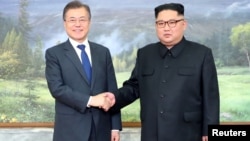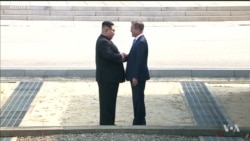South Korean President Moon Jae-in travels to Pyongyang Tuesday with a delegation numbering nearly 200, including leaders from some of the country's largest companies, for his third summit with North Korean leader Kim Jong Un.
The meeting will not only focus on issues related to denuclearization and improving Inter-Korean ties, but will serve as a platform to see if Moon can cement his role as facilitator between Pyongyang and Washington.
Skepticism remains over whether the North Korean leader is serious about denuclearization. Asan Institute for Political Studies Visiting Research Fellow Cheon Seong Whun told VOA, “It’s not crystal clear that Kim Jong Un and [the] North Korean regime is willing to give up all those nuclear weapons and programs.”
Moon’s focus
Seoul officials say Moon’s primary focus of the summit is to improve and develop inter-Korean relations. It’s expected that Moon and Kim will work to further implement the items outlined in the April 27 Panmunjom Declaration.
His second objective is to mediate and promote denuclearization dialogue between North Korea and the United States.
Washington and Pyongyang have been at odds over what should come first: denuclearization or declaring a formal end to the war, as the 1950-53 Korean War ended with an armistice, not a peace treaty. That has left North Korea still technically at war with the U.S.-led United Nations coalition.
Im Jong-seok, Inter-Korean Summit Preparation Committee Chair and Presidential Chief of Staff, told reporters that U.S. President Donald Trump has asked President Moon to facilitate dialogue between Washington and Pyongyang and convey back to the American leader information from the North to move negotiations along.
At the summit’s conclusion, President Moon may also sign a "comprehensive military agreement.” That agreement was one of the points outlined in the Panmunjom Declaration, where Moon and Kim agreed to implement practical measures to prevent accidental clashes and ease military tensions.
Working-level military talks last week, spanning two days, were focused on finalizing the agreement before the summit, but Im left open the possibility that additional work on it could be done on it at a later date.
President Moon will also stress the need to resolve lingering issues regarding separated families from the Korean War, in which the elderly survivors are approaching the twilight of their lives. Officials say there has been some progress on that front, as demonstrated by the recent Mt. Kumgang family reunions, and the possibility of future video-calls between separated loved-ones.
Troy University International Relations lecturer Daniel Pinkston said there are a number of expectations for this third summit, not only in South Korea, but in the United States and throughout the region “regarding confidence building measures on the security side,”movement towards arms reduction, and concrete action “the nuclear area.”
WATCH: Preparing for Korea talks
South Korean delegations
Currently in Pyongyang is President Moon’s advance team of nearly 100 officials. Suh Ho, the presidential secretary for unification policy leads the team consisting of government officials, staff, and reporters.
Over 50 government officials, politicians, business leaders, and other representatives will travel with President Moon Tuesday morning to Pyongyang. The group will make the trip using “the direct western air route,” according to a presidential official.
In addition to Foreign Minister Kang Kyung-wha, Defense Minister Song Young-moo, and Unification Minister Cho Myoung-gyon, other delegates attending the inter-Korean summit include Samsung Vice Chairman Lee Jae-Yong, Seoul mayor Park Won-soon, and K-pop stars Zico and Ailee.
The youngest member of the South Korean delegation was to be 15-year-old Kim Gyu-yeon. The middle school student is the granddaughter of Kim Hyun-soo, who participated in the inter-Korean reunions. Her trip to North Korea was canceled when Pyongyang informed the South that it would not be possible to meet her family during the inter-Korean summit.
Schedule of events
South Korean President Moon Jae-in and his delegation are expected to land in Pyongyang at 10 a.m. Korea Standard Time (0100 UTC) Tuesday. An official welcome ceremony is planned at the airport to commemorate their arrival.
Participants are scheduled to have lunch prior to beginning talks. During those discussions, President Moon’s wife, Kim Jong-sook, will visit a children’s hospital and a music college, as she is a classically trained singer.
Other delegation members will attend concurrent meetings. Some will meet with the Standing Committee Chairman of the Supreme People’s Assembly, while business leaders will visit with the Cabinet Deputy Prime Minister.
Following the first round of talks, a welcome art performance is planned to take place during the the afternoon, which will be followed by a welcome dinner. The location has yet to be released although South Korean Presidential Chief of Staff lm Jong-seok expressed hope it would be a restaurant frequented by residents, since President Moon likes to visit local restaurants on his travels.
Moon and Kim may hold a joint press conference Wednesday to announce any agreements made during the third inter-Korean summit, provided some are reached. That would be followed by a farewell dinner that evening and a ceremony at the airport on the 20th as the delegation prepares to return to South Korea.














